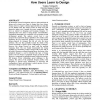Free Online Productivity Tools
i2Speak
i2Symbol
i2OCR
iTex2Img
iWeb2Print
iWeb2Shot
i2Type
iPdf2Split
iPdf2Merge
i2Bopomofo
i2Arabic
i2Style
i2Image
i2PDF
iLatex2Rtf
Sci2ools
DESRIST
2009
Springer
2009
Springer
Power of peripheral designers: how users learn to design
In information system development, end-users often participate in design and in many cases learn to design their own system. Design, however, requires a distinct approach that users typically are not familiar with. The unique position in which users find themselves makes users’ learning even more complicated: They have no interest in designing and becoming designers. To understand how users learn to design despite such difficulties, longitudinal ethnography was conducted in an accounting system development project. The analysis reveals how a user progressively acquired the design capability in two months. In the beginning, the user treated the problem as given and rejected design proposed by designers that did not solve the given problems. The user then gradually learned the details of the system and started to explore various configurations of features; however, this design focused on parts, with the problem remaining fixed. The user finally demonstrated her design capability by co...
Design | DESRIST 2009 | Education | Peripheral Designer | User |
Related Content
| Added | 24 Jul 2010 |
| Updated | 24 Jul 2010 |
| Type | Conference |
| Year | 2009 |
| Where | DESRIST |
| Authors | Yutaka Yamauchi |
Comments (0)

